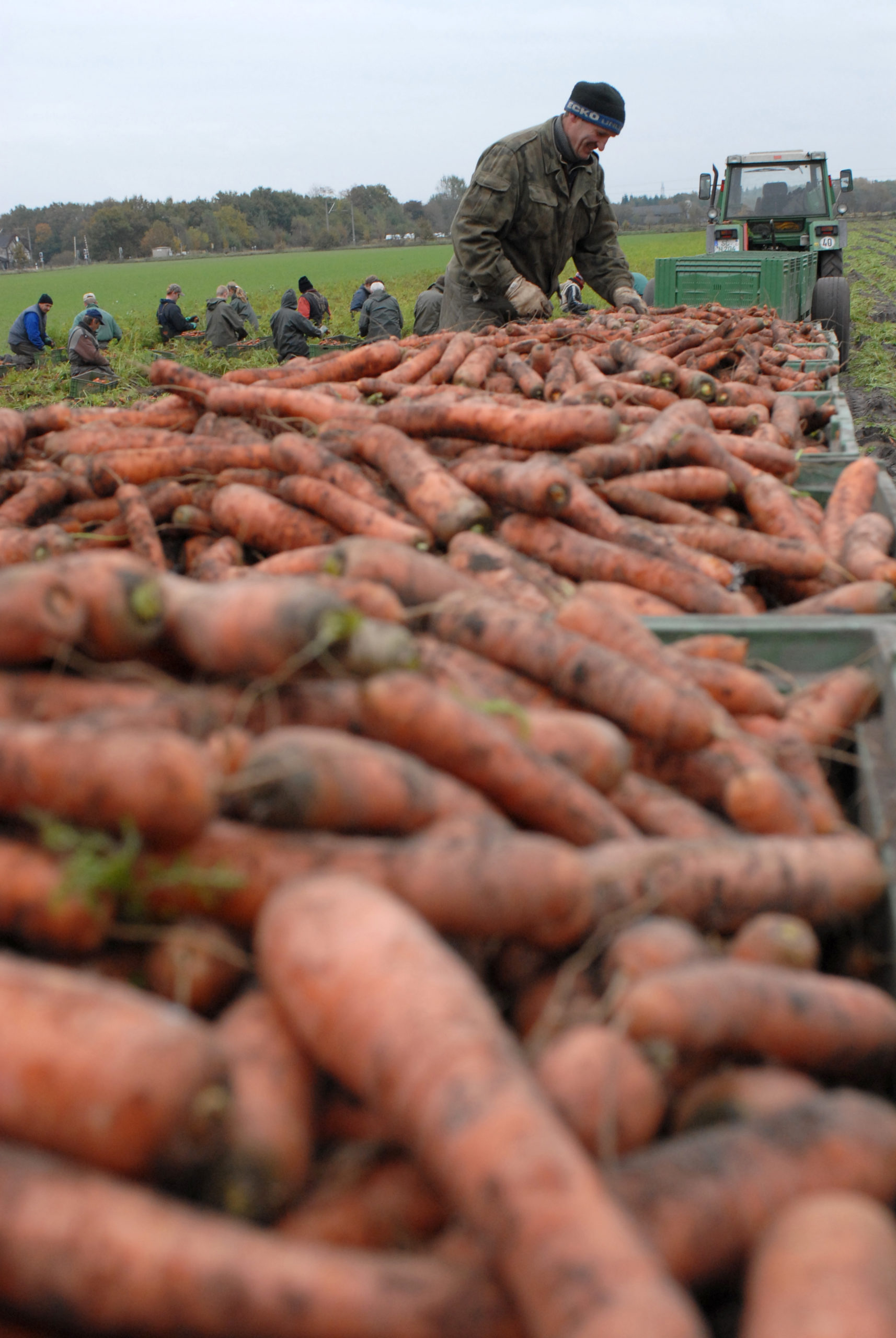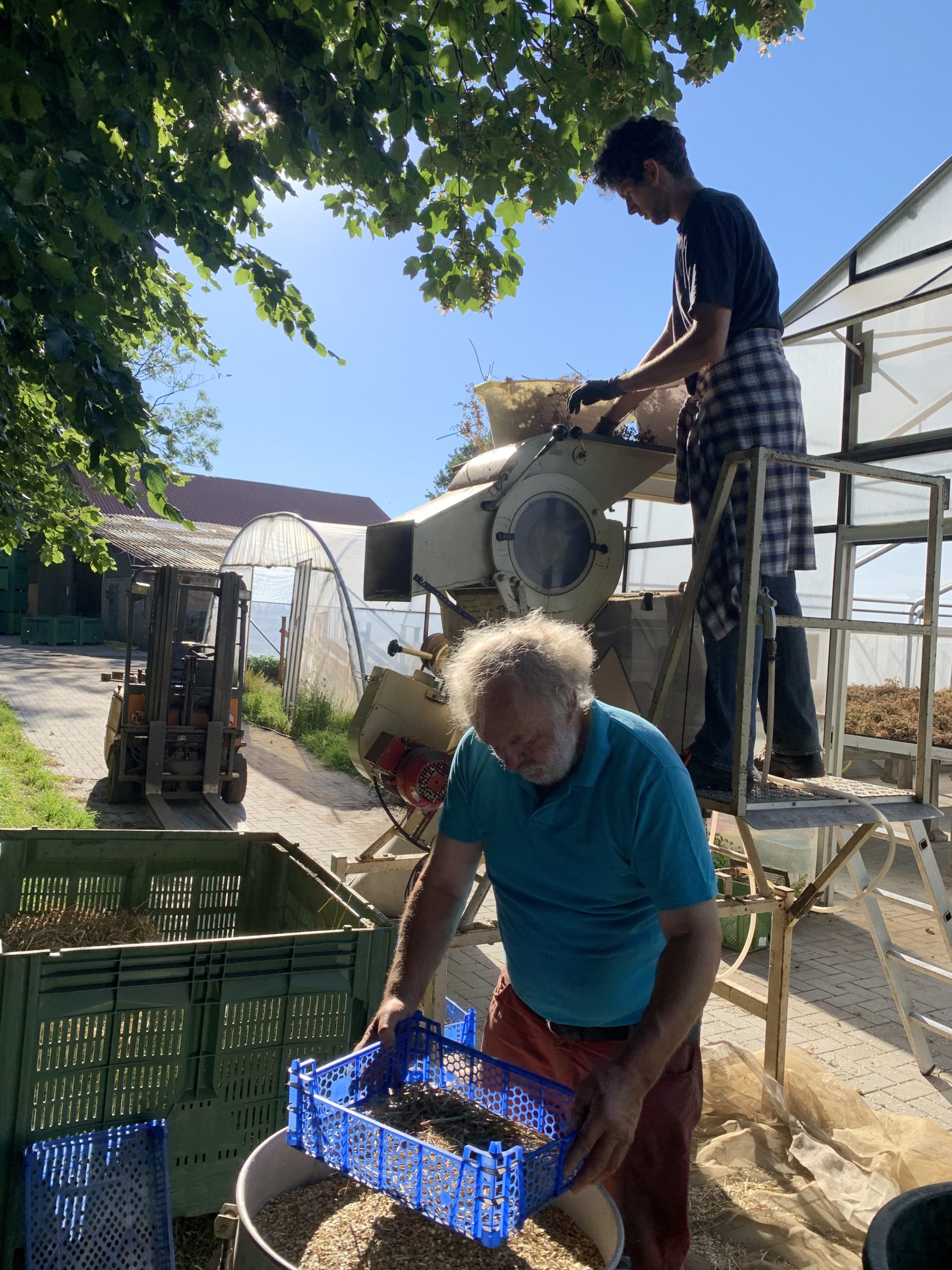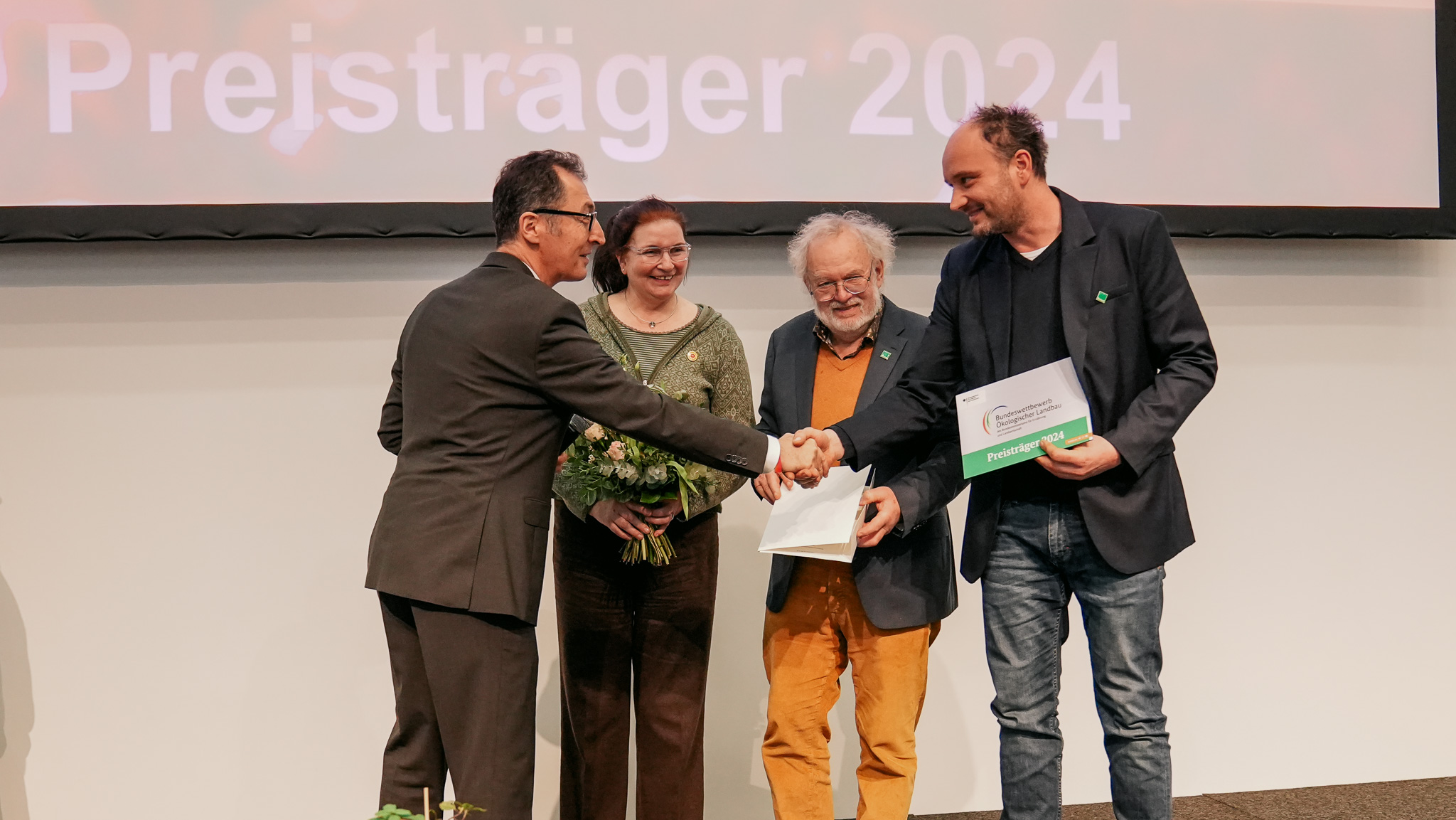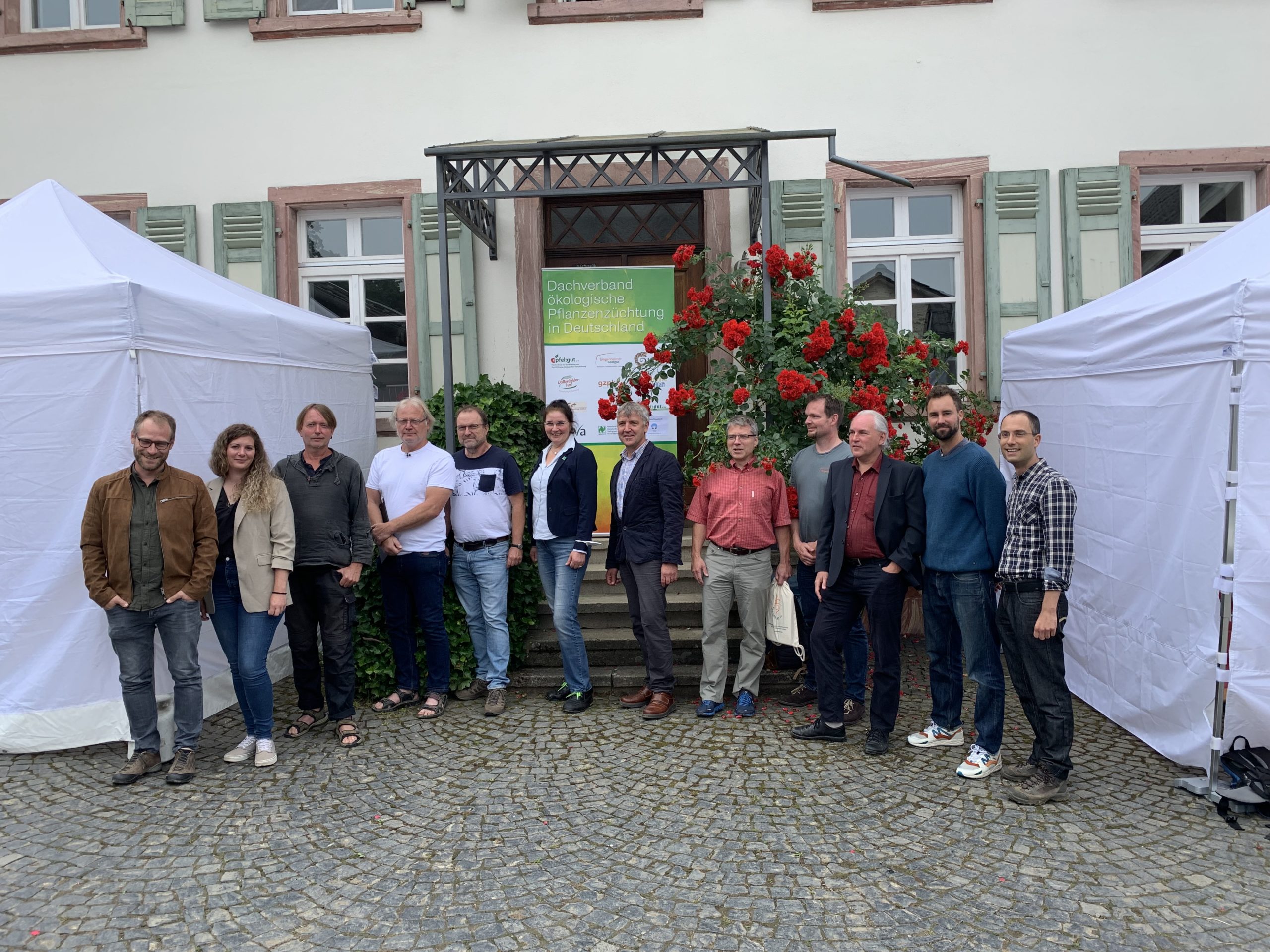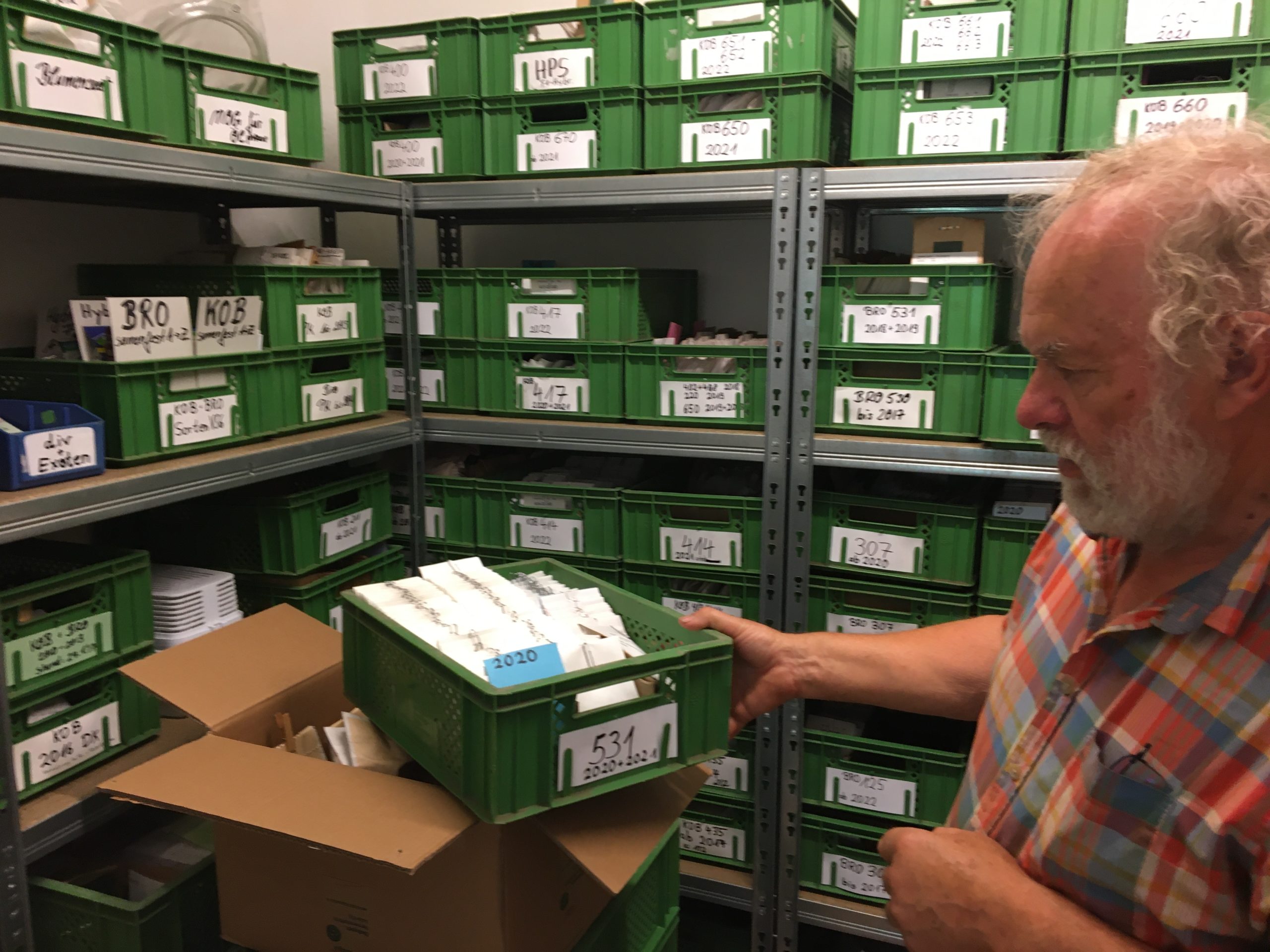Time waits for nobody – but it seems to travel quickly or slowly depending on circumstance. Organic breeding techniques have a different relationship to time and place than genetic engineering methods; other aspects of being in a market economy and of using specialised machinery have their own relationships to time too. Here, Hannes Lorenzen talks with organic plant breeders in Christiansen organic farm, up in Schleswig-Holstein, in the far north of Germany and what they do and why they do it.
Barbara Maria and Heinz Peter stand happily in front of their new washing and sorting machine for root vegetables. It has just arrived from Poland and is gleaming in the newly opened processing hall. You can literally see the effort they have put in recently, but also the relief. Previously, cleaning, washing, sorting and packing carrots, beetroot and parsnips took place at different locations on their farm. This was time-consuming and tedious.
“The new “beast” will be a real relief for the whole crew,” says Barbara Maria happily. “We now hopefully have more time for our diverse and labour-intensive vegetable cultivation and organic breeding.”
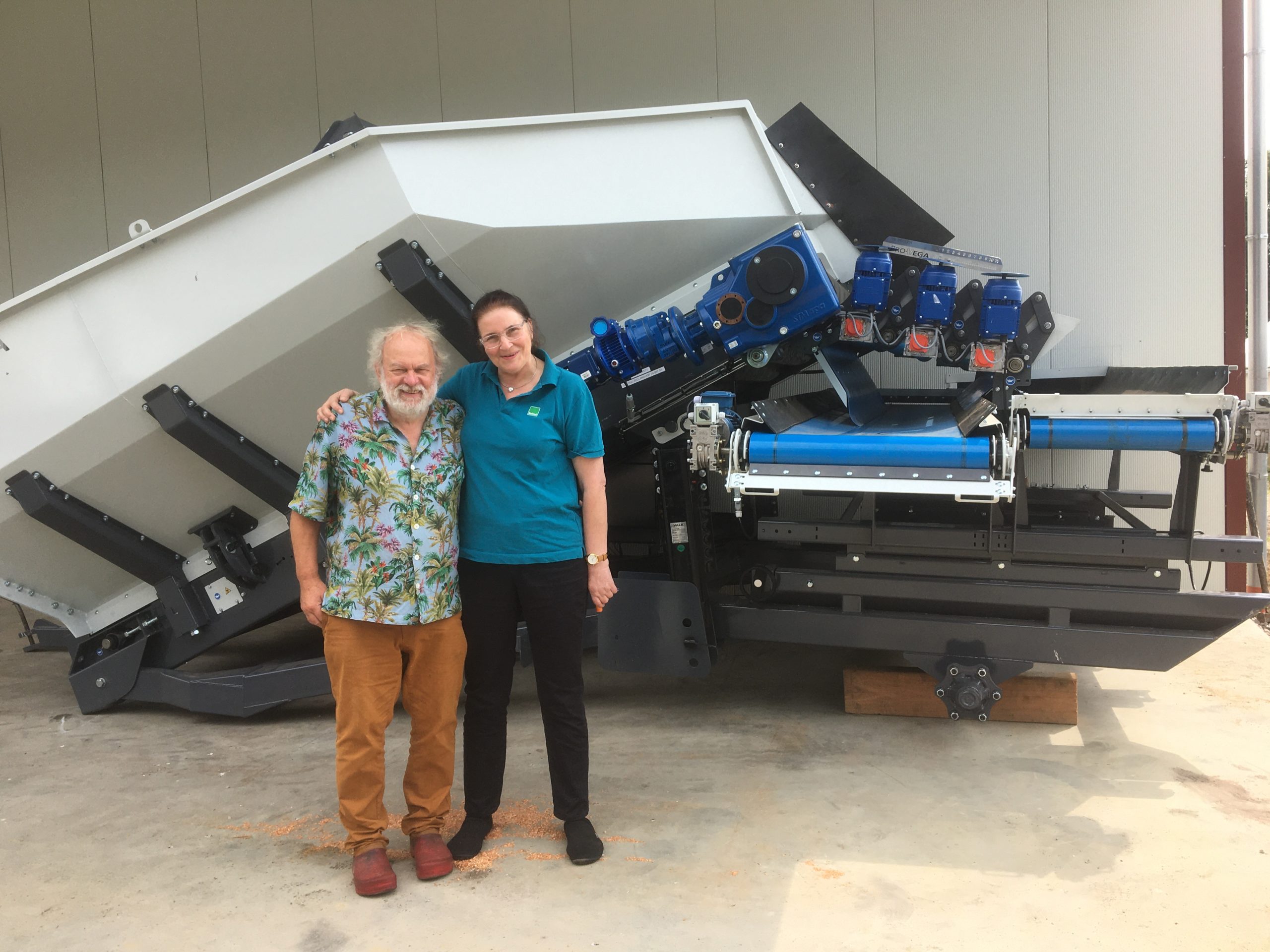 HP Christiansen and BM Rudolf at their new washing and sorting machine. Photo Hannes Lorenzen
HP Christiansen and BM Rudolf at their new washing and sorting machine. Photo Hannes Lorenzen
Barbara Maria Rudolf is the managing director of the Christiansen organic farm in Esperstoftfeld in Schleswig-Holstein, in the far north of Germany. She runs the farm together with her partner Heinz-Peter Christiansen. When he took over the farm from his grandparents, it was just 35 hectares in size. Now the vegetable farm is one of the leading organic producers in the region with around 120 hectares and twenty employees.
From harvesting to packing, the work is tightly synchronised. Every week, three lorries of fresh vegetables are dispatched to wholesalers and retailers in northern Germany. That’s around 20 tonnes of food, which has to be delivered to customers with great care and as fresh as possible. Time is short. Good logistics and a perfect division of labour play an important role at this scale.
A different perception of time
Heinz Peter and his parsnip seed. Photo Hannes Lorenzen
Right next to the processing hall, in one of the farm’s many greenhouses, a different perception of time seems to be at work. Heinz Peter is now standing in front of a mountain of brown-yellow cones.
“This is seed from our parsnips,” he explains. It’s not so easy to harvest the seed in such a way that not too much is lost. That’s why I collect the cones by hand. I can’t count the hours I spend doing this. Nobody pays me for them. But so far there’s no other way. Anyone starting out in organic breeding needs a lot of patience anyway. I started a good fifteen years ago, and I now know how much time I need to understand what actually happens in the plants during breeding, what characteristics they bring with them and develop, what is stable or unstable, and what is most important for our needs as breeders, for commercial farmers, and of course the expectations of our consumers.”
Spoilt for choice
We take a tour of the 40 greenhouses, in which nothing of the vegetables I have just seen in the fields can actually be recognised. Instead, it is blooming and humming everywhere. Bumblebees pollinate the selected cauliflower, broccoli, beetroot and carrot plants, which are closely monitored by Heinz Peter.
“There are a lot of very different criteria that we use to select plants for breeding,” he explains. “Above all, they have to be healthy and resistant to diseases and pests, as chemicals are not used in organic farming. A stable yield is also important, as is the external quality expected by retailers and customers. Cauliflowers, carrots and parsnips must be the same size as far as possible so that they are easy to clean and pack. The colour must be right, but of course the taste and aroma must also be right. Please find out how you can combine all of this in one plant! One is hardy but doesn’t taste good, the other has a beguiling fragrance but goes bad quickly. You can’t tell from the flowers, nor from the roots. You have to observe closely how the plants change before and after crossing. And you can’t do everything at the same time. You have to know your plants from the ground up to get the best out of them for organic farming and your customers at the same time.”
Cauliflowering in the tunnel (c) HL
Precaution
© Barbara Maria Rudolf Harvest of Treenetaler Carrots
Next door, in the greenhouse for the Treenetaler Moorübe, a premium product that is sold to customers as unwashed carrots, I discover small open bags next to the seed containers that are tied together over the cones.
“These are beneficial insects that we use against pests as early as possible before any major damage occurs,” explains Heinz Peter. We often discover this too late ourselves, so we work with a colleague who keeps a close eye on our crops and takes action before it’s too late. Time also plays a role here. Incidentally, our bog carrots are particularly appreciated for its incomparable flavour and fragrance . This is also due to our soil, which is rich in humus, sandy and, above all, black soil.”
Interaction on site
“What grows well in our fields and pleases our customers is the result of the interplay between breeding and cultivation,” says Barbara Maria, who has joined us. “We carry out complex breeding because we want to improve our cultivation here on site and ensure free access to suitable varieties and seeds for organic farming. We can check what works and what doesn’t right here in the fields. These are short distances. If Jan, our production manager, says dat löppt gut, we continue in the same direction, if he says “dat bringt nix!” we have to change something. It’s not so easy to find a good balance between the external quality that the wholesale trade and customers demand and the internal quality that we want for cultivation, long-term breeding and healthy food”.
Threshing Parsnip seed (c) Hannes Lorenzen
Organic, right from the start
Barbara not only runs the business for the farm, she also connects the inner world of the farm with the outer world of networking and politics. She initiated the Saat:gut project, which is now managed by Heinz-Peter. Together with other committed farmers, they founded the Saat:gut association, a non-profit organisation that aims to strengthen the resilience of farmers against the market power of a few multinational seed companies.
The project opposes the use of genetic engineering in breeding and the patenting of plants. But by publicising and promoting organic plant breeding, it also offers an alternative for colleagues and customers. Food produced with seeds from this breeding is labelled accordingly as Bioverita with the help of the relevant wholesalers. Bioverita e.V. is a non-profit organisation based in Switzerland that makes the added value of organic breeding visible along the value chain at all levels.
Independence means resilience
“Until now, organic breeding and its importance have hardly been recognised,” explains Barbara Maria. “This is also due to the fact that our work has so far been largely voluntary. Conventional breeding centres and seed companies demand that farmers pay replanting or even patent fees in order to finance their breeding. And they prohibit growers from reproducing their varieties if they do not pay the fees.
We, on the other hand, produce open pollinated varieties that, unlike hybrid varieties, any farm can reproduce without paying fees. We do not breed to prevent our colleagues from utilising our successes. On the contrary, we want our seeds, which adapt to climate change and environmental changes, to spread widely.
That is why we need public and non-profit support for our work. Our trading partners and foundations such as the Foundation for Future Farming with its seed fund and the Gerd-Godt-Grell Foundation are already supporting us. However, the declaration of intent from politicians has so far not been followed by much in the way of substance. Federal Minister of Agriculture Özdemir has not yet honoured his promise to promote organic plant breeding. But at least he has recognised our pioneering breeding achievements this year with the Federal Prize for Organic Farming.”
(Image 6 The award ceremony)
(c) BMR Federal Minister Özdemir with award winner Christiansens Biolandhof
Boring hybrids
Because there has been so little political movement on organic breeding so far, in 2022 Barbara Maria and her colleagues founded a joint interest group, the Dachverband Ökologische Pflanzenzüchtung inDeutschland e.V. (Image 7 Founding event of the umbrella organisation) They want to help shape the framework conditions with which organic plant breeding is defined, publicised and financially and politically supported. The aim is also to develop the market for organic seed and encourage companies to participate in this development.
“Because there is so much pressure from wholesalers to deliver standardised goods in large quantities at a specific time, organic vegetable cultivation mainly uses hybrids (F1), that is, seeds that only produce high yields once but have to be bought again and again. If an attempt is made to reproduce the hybrid, a completely different picture emerges in the next generation (F2): the variety splits into very different phenotypes. The uniformity is gone. Variety development has to start from scratch, including adaptation to changing climatic conditions. Nature’s method of adapting to changing conditions is diversity. Each variety reacts slightly differently. With such volatile conditions as we have experienced in recent years, it is also advisable for agriculture to adapt through more diversity. Organic plant breeding helps to increase agrodiversity and thus contributes to more resilient farming systems. We move with the times ” Heinz Peter smiles.
Founding members of the Federation of German organic breeders (c) BMR
Turbo breeding
“Genetic engineering offers a supposedly rapid acceleration in breeding,” says Heinz-Peter. “Using laboratory methods such as gene scissors and other processes that skip natural adaptation steps and crossing procedures, the genetic structure of plants is taken apart and reassembled. This harbours many risks because very specific characteristics are changed while others are not taken into account. The justification for using this technique is often that we don’t have the time and that traditional breeding methods are too slow to adapt to climate change.”
He continues: “For me, however, breeding in the laboratory makes no sense: it takes the plants out of the environment, which is constantly changing, and comes back from the laboratory with “miracle” plants that are often not at all suited to the new environmental conditions. Organic breeding initially requires more time because we have to observe and take into account complex interrelationships. Quick fixes are more of a risk for growers. Our varieties are adapted to the requirements of organic farming: Breeding objectives, selection conditions and suitability for cultivation – everything is geared towards organic farming and takes place under organic conditions. We are part of a network of demonstration farms in Germany where our experience and methods are passed on,” explains Heinz Peter.
From our own variety development there are now 2 varieties of parsnip (Schleswiger Schnee, Primera), 2 varieties of beetroot (Gesche, Angela), 4 varieties of carrot (Bollin, Treenetaler, ASAP (103), Miso (112), as well as some amateur varieties that are still being trialled. Other cauliflower and broccoli candidates are in national variety trials to gain further knowledge for the forthcoming authorisations. We are using our time.”
What is organic breeding?
Breeding means the deliberate selection and crossing of two plants with characteristics that are of interest to agriculture/horticulture. Specialised organic plant breeding and variety development is about preserving and expanding genetic diversity as far as possible and developing new varieties and populations that are particularly suitable for organic production systems. Organic plant breeding respects natural crossing barriers and focusses on resistance to pests and the ability to adapt to changing climate and growing conditions.
The Seed collection. photo Hannes Lorenzen
A question of time
We are now standing in the ventricle of the farms breeding diversity, the Elite Seed Collection. This is where Barbara and Heinz Peter have collected, described and catalogued their breeding successes by trait over the last fifteen years.
“We can draw on this treasure trove at any time in our work,” explains Barbara. “If we think a cauliflower or carrot variety is ripe, Saat:gut e.V. registers the variety. We then pass it on to organic seed propagators, who market it to commercial and hobby gardeners via catalogues. We have also tried to find ways to speed up our breeding work by having our seeds reproduced on the Canary Islands. But in the end we didn’t gain any time. It’s not much different in politics. We have heard a lot of announcements and promises to promote organic farming and organic breeding, even a new EU regulation that explicitly mentions organic breeding and provides for easier market access for organically bred varieties. We are still in dialogue with the variety offices to make this a reality. The time will come at some point. It’s just a question of time.”
© BMR The Christiansen Farm crew.
The Christiansenhof
The farm management team of Heinz-Peter Christiansen, Barbara Maria Rudolf and Jan Richardt manage the 120-hectare farm with around 20 employees. In addition to potatoes, the most important crops are carrots, beetroot, broccoli, cauliflower, radishes and parsnips. These crops are grown on the farm and are also further developed through breeding. Products from the organically grown varieties are marketed in cooperation with Bioverita e.V.





